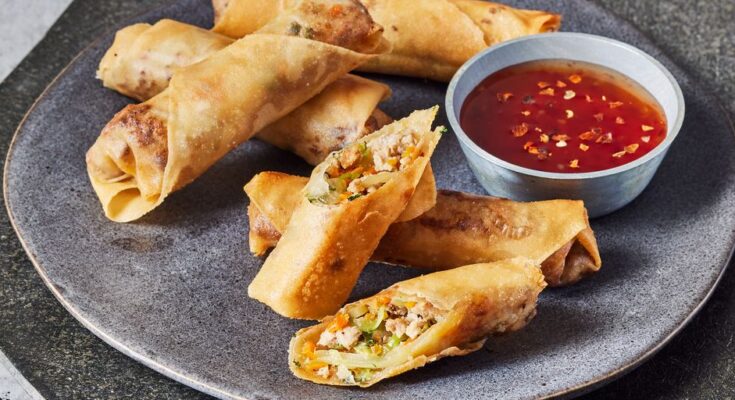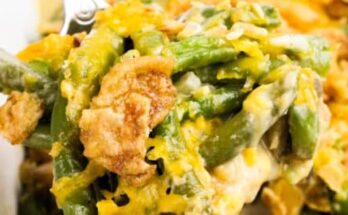Filipino Lumpia Recipe: Lumpia is one of the most beloved dishes in the Philippines, and if you’ve ever attended a Filipino gathering, chances are you’ve seen these golden, crispy rolls served on the table. Lumpia is the Filipino version of spring rolls, but what makes it unique is its perfectly seasoned filling and thin, crunchy wrapper. Whether served as a snack, appetizer, or even the star of the meal, Lumpia has earned its place as a comfort food not only in Filipino households but also worldwide.
The cultural significance of Lumpia runs deep. In Filipino celebrations—birthdays, weddings, fiestas—you’ll always find Lumpia as a staple dish. It represents sharing, joy, and the Filipino love for gatherings. Many families pass down their own secret recipes, making each version slightly different but equally delicious.
What makes Lumpia stand out is its versatility. You can fill it with ground pork, beef, chicken, shrimp, or vegetables depending on your preference. Some like it meaty and savory, while others prefer a light, fresh taste with greens and tofu. This flexibility is what keeps Lumpia exciting and appealing to different palates.
No wonder Lumpia has gained popularity beyond the Philippines. From Filipino restaurants abroad to home kitchens worldwide, people crave its crispy bite and savory filling. If you’ve never tried making it at home, don’t worry—we’ve got a simple step-by-step guide for you.
By the end of this recipe guide, you’ll know exactly how to prepare, wrap, and fry Lumpia so you can impress your family and friends with this Filipino classic.
Ingredients You’ll Need
Making Lumpia is surprisingly simple once you have the right ingredients. Below is a detailed breakdown of everything you’ll need.
Main Ingredients for Lumpia Filling
The filling is the heart of Lumpia, and you can customize it based on your taste. The most common version is Lumpiang Shanghai, made with ground pork. Here’s a basic list:
- 1 lb ground pork (or substitute with chicken, beef, or shrimp)
- 1 cup carrots, finely grated
- 1 cup cabbage, finely shredded
- 1 small onion, finely chopped
- 3 cloves garlic, minced
- 2 tbsp soy sauce
- 1 tbsp oyster sauce (optional, for richer flavor)
- 1 tsp ground black pepper
- 1 tsp salt
- 1 egg (helps bind the filling)
Lumpia Wrapper Essentials
The wrapper is what gives Lumpia its signature crunch. You can buy ready-made wrappers at Asian grocery stores. Look for:
- Lumpia wrappers (thin, about 8–10 inches wide)
- Water or egg wash (to seal the edges)
If you can’t find Lumpia wrappers, spring roll wrappers are a decent substitute, but the texture will be slightly different.
Optional Add-ons for Extra Flavor
Want to take your Lumpia up a notch? Try adding these:
- Chopped shrimp (adds a touch of sweetness and texture)
- Green onions (for freshness)
- Bean sprouts (for crunch)
- Bell peppers (for sweetness and color)
- Tofu (for a vegetarian version)
These little tweaks can transform your Lumpia into something special and tailor it to your own preferences.
Kitchen Tools and Preparation Tips
Before we jump into cooking, it’s important to have the right tools ready. Lumpia isn’t complicated, but a few essentials will make the process smoother.
Tools to Make Lumpia-Making Easier
- Mixing bowls – to combine your filling.
- Sharp knife & chopping board – for slicing vegetables finely.
- Measuring spoons/cups – to balance the seasoning.
- A spoon or small scoop – for portioning the filling.
- Clean kitchen towel – to keep wrappers moist and prevent drying.
- Deep frying pan or wok – for frying.
- Slotted spoon or tongs – to safely remove fried Lumpia.
Having these tools on hand ensures the preparation goes smoothly and efficiently.
How to Prep Your Ingredients Ahead of Time
Lumpia is best when prepared fresh, but you can save time by prepping ingredients in advance. Here’s how:
- Chop all vegetables ahead of time and store them in an airtight container in the fridge.
- Mix the filling a few hours before wrapping and refrigerate until ready to use.
- Defrost wrappers properly by leaving them at room temperature—don’t rush this step, or they’ll tear easily.
- Prepare dipping sauces (like sweet chili sauce or vinegar with garlic) so they’re ready to go.
Doing this prep work makes Lumpia assembly faster, especially if you’re making a large batch for a party.
Step-by-Step Guide to Making Lumpia
Here comes the exciting part—assembling and cooking your Lumpia. With a little patience, you’ll have golden, crunchy rolls ready to serve.
Step 1 – Preparing the Lumpia Filling
Start by cooking some of the ingredients lightly. Heat a small pan with a tablespoon of oil, then sauté garlic and onions until fragrant. Add ground pork and cook until it changes color. Mix in soy sauce, oyster sauce, salt, and pepper. Toss in shredded carrots and cabbage. Don’t overcook the vegetables; you want them slightly crisp for texture. Remove from heat and let the filling cool.
Once cooled, mix in one beaten egg. The egg binds the mixture, making it easier to roll. Taste the filling at this point and adjust seasoning if needed. This step ensures your Lumpia will be flavorful inside and out.
Step 2 – Wrapping the Lumpia Properly
Wrapping Lumpia might look tricky at first, but once you get the hang of it, it becomes second nature. Lay one wrapper flat on a clean surface, with one corner pointing toward you (like a diamond shape). Place about one to two tablespoons of filling near the bottom corner. Be careful not to overfill—too much filling makes the wrapper tear or the roll burst during frying.
Next, fold the bottom corner tightly over the filling. Roll halfway up, then fold the left and right corners inward to seal the sides. Continue rolling until you reach the top corner, keeping the roll tight but not too tight (you don’t want it to rip). Seal the edge with a dab of water or egg wash.
Repeat this process until you’ve used up all the filling. To prevent the wrappers from drying out, cover the rolled Lumpia with a slightly damp towel while you work. This little trick keeps them soft and easy to handle before frying.
If you’re new to wrapping Lumpia, don’t worry if your first few rolls look uneven. With practice, you’ll master that perfect tight, slim roll. The key is consistency—aim for rolls that are about finger-sized so they cook evenly.
Step 3 – Frying Lumpia to Golden Perfection
Now comes the best part: frying. Heat about 2 to 3 cups of oil in a deep frying pan or wok. The oil should be hot but not smoking—around 350°F (175°C) is perfect. To test, dip the end of a wooden chopstick into the oil; if bubbles form, it’s ready.
Carefully place a few Lumpia rolls into the hot oil, seam side down. Don’t overcrowd the pan, or the temperature will drop, and your Lumpia won’t crisp properly. Fry each batch for about 3–4 minutes, turning occasionally, until they’re golden brown and crispy.
Once done, transfer the Lumpia to a plate lined with paper towels to absorb excess oil. Let them rest for a minute or two before serving. This not only keeps them crisp but also prevents burning your mouth when you take that first delicious bite.
And there you have it—crispy, golden, irresistible Lumpia, ready to be enjoyed.
Tips for Perfect Lumpia Every Time
Even though Lumpia is simple to make, a few tips can make the difference between “just okay” and “restaurant quality.”
Common Mistakes to Avoid
- Overfilling the wrapper – This makes the Lumpia burst while frying. Stick to a small amount of filling.
- Not sealing properly – If the edge isn’t sealed, the Lumpia will open in the oil. Always use water or egg wash to close tightly.
- Oil too hot or too cold – Too hot, and the wrapper burns before the filling cooks; too cold, and the Lumpia absorbs oil and turns soggy. Keep it steady around 350°F.
How to Keep Lumpia Crispy Longer
Nothing beats biting into freshly fried Lumpia, but if you’re serving them for a party, you want them to stay crisp. Here’s how:
- Place fried Lumpia on a wire rack instead of paper towels so the air circulates and prevents sogginess.
- Keep them warm in a low oven (around 200°F/90°C) until serving.
- Avoid covering them with foil or a lid—it traps steam and makes them soft.
By following these tricks, your Lumpia will stay crunchy and delicious, even after sitting for a while.
Serving Suggestions
Now that your Lumpia is ready, how do you serve it? This dish is versatile, making it a crowd-pleaser at any event.
Best Dipping Sauces for Lumpia
The right dipping sauce takes Lumpia to the next level. Some popular choices include:
- Sweet chili sauce – A perfect balance of sweet, spicy, and tangy.
- Vinegar with garlic and chili – A Filipino favorite, offering a sharp contrast to the savory filling.
- Banana ketchup – A sweet and uniquely Filipino twist.
- Soy sauce with calamansi – Simple yet refreshing.
Try offering a few dipping sauces so guests can choose their favorite.
How to Serve Lumpia for Parties and Gatherings
Lumpia is best enjoyed hot and crispy, straight from the fryer. For parties, arrange them neatly on a large platter with dipping sauces in small bowls. You can also serve them as finger food on cocktail sticks for easy grabbing.
Pair Lumpia with fried rice, pancit (Filipino noodles), or even a simple salad for a full meal. Whether as an appetizer or the main star, Lumpia never fails to impress.
Variations of Lumpia
One of the best things about Lumpia is its adaptability. Depending on where you are in the Philippines—or in the world—you’ll find unique twists on this beloved dish. Let’s take a look at some of the most popular versions.
Lumpiang Shanghai
This is the most common and internationally recognized version of Lumpia. It’s usually filled with ground pork, carrots, onions, garlic, and seasonings. Rolled tightly and fried until golden, it’s the star of Filipino parties. What makes Lumpiang Shanghai stand out is its size—slimmer and shorter than other types, making it easy to eat as finger food. Dipped in sweet chili sauce, this version is almost impossible to resist.
Fresh Lumpia (Lumpiang Sariwa)
Unlike its fried cousins, Lumpiang Sariwa is served fresh with a soft, crepe-like wrapper. The filling is usually a mix of sautéed vegetables like carrots, cabbage, bean sprouts, and green beans. It’s then topped with crushed peanuts and a savory-sweet peanut sauce. This healthier version is light yet satisfying, offering a completely different experience while still carrying that signature Filipino flavor.
Vegetarian Lumpia
For those who don’t eat meat, vegetarian Lumpia is a fantastic option. The filling can be made with tofu, mushrooms, bean sprouts, carrots, and cabbage. With the right seasoning, it’s just as flavorful and satisfying as the meaty versions. Some even add glass noodles for extra texture. This variation is perfect if you’re looking for a lighter or plant-based snack.
Of course, there are countless regional versions—some include shrimp, others use banana blossoms or heart of palm. The beauty of Lumpia is that you can make it your own while still keeping the essence of the dish intact.
Storing and Reheating Lumpia
Making Lumpia is often a big task, so it’s common to prepare them in bulk. Thankfully, they store well, and with the right methods, you can enjoy Lumpia any time without losing that crunch.
How to Freeze Uncooked Lumpia
If you’re making Lumpia for a future event, freezing is the best way to preserve them. Once wrapped, lay the uncooked rolls in a single layer on a baking sheet, making sure they don’t touch each other. Place them in the freezer for about an hour until firm. After that, transfer them into a freezer bag or airtight container. This prevents them from sticking together.
Frozen Lumpia can last up to three months. The best part? You don’t need to thaw them before frying. Just place them directly in hot oil, but remember to fry them a little longer to ensure the filling cooks through.
Best Way to Reheat Leftover Lumpia
If you have leftover fried Lumpia, reheating them properly is key to keeping that crispy texture. Avoid microwaving—this makes the wrapper soggy. Instead:
- Reheat in the oven at 375°F (190°C) for 10–12 minutes.
- Or re-fry quickly in hot oil for 1–2 minutes until crisp again.
Both methods will restore that satisfying crunch and make your Lumpia taste almost as fresh as the first time.
Nutritional Value of Lumpia
Lumpia is delicious, but like many fried foods, it should be enjoyed in moderation. Still, it offers some nutritional benefits, depending on the filling you choose.
Health Benefits and Concerns
Traditional Lumpiang Shanghai is rich in protein thanks to the ground pork or chicken. The vegetables add vitamins, minerals, and fiber, which balance the dish out a bit. However, because Lumpia is deep-fried, it also comes with added calories and fat.
One serving of Lumpiang Shanghai (about 3–4 pieces) can have 200–300 calories, depending on the size and filling. It’s fine as an occasional treat, but eating too many might not be the healthiest choice.
How to Make Lumpia a Bit Healthier
If you want a lighter version, here are some tips:
- Bake instead of fry – Brush Lumpia lightly with oil and bake at 400°F (200°C) for 20 minutes until crisp.
- Air-fry – This gives you the same crunch with much less oil.
- Use lean meat – Ground chicken or turkey are great substitutes.
- Add more vegetables – Increase cabbage, carrots, or bean sprouts for added nutrients.
With these adjustments, you can still enjoy the flavor of Lumpia without feeling guilty.
FAQs about Filipino Lumpia Recipe
Can I bake Lumpia instead of frying?
Yes! Baking is a healthier option. Brush or spray the rolls with a bit of oil and bake at 400°F (200°C) until golden brown and crispy. It won’t be as crunchy as deep-fried, but it’s still tasty.
What’s the difference between Lumpia and spring rolls?
Lumpia is the Filipino take on spring rolls. The wrappers are thinner and crispier when fried, and the filling often includes ground meat and finely chopped vegetables, seasoned Filipino-style. Chinese spring rolls are usually thicker and can have a wider variety of fillings.
How long does Lumpia last?
Cooked Lumpia can last 2–3 days in the fridge if stored in an airtight container. Frozen uncooked Lumpia can last up to three months. Always reheat properly to bring back the crunch.
Can I make Lumpia ahead of time for a party?
Absolutely! You can wrap them a day before, cover them with a damp towel, and refrigerate. Fry just before serving for maximum crispiness.
What sauces go best with Lumpia?
Sweet chili sauce is the classic choice, but vinegar with garlic and chili, banana ketchup, or soy sauce with calamansi are also popular Filipino pairings.
Conclusion
Lumpia isn’t just food—it’s a piece of Filipino culture wrapped in a crispy shell. From family celebrations to everyday snacks, it has a special place in the hearts (and stomachs) of many. The best part? It’s easy to make at home, and you can customize the filling to suit your taste.
Whether you stick with the classic Lumpiang Shanghai, go for a fresh version, or try a vegetarian twist, the process of preparing Lumpia is just as rewarding as eating it. Once you take that first crunchy bite, you’ll understand why it’s such a favorite around the world.
So grab your wrappers, prepare your filling, and start rolling—you’re just a few steps away from enjoying this timeless Filipino classic.



